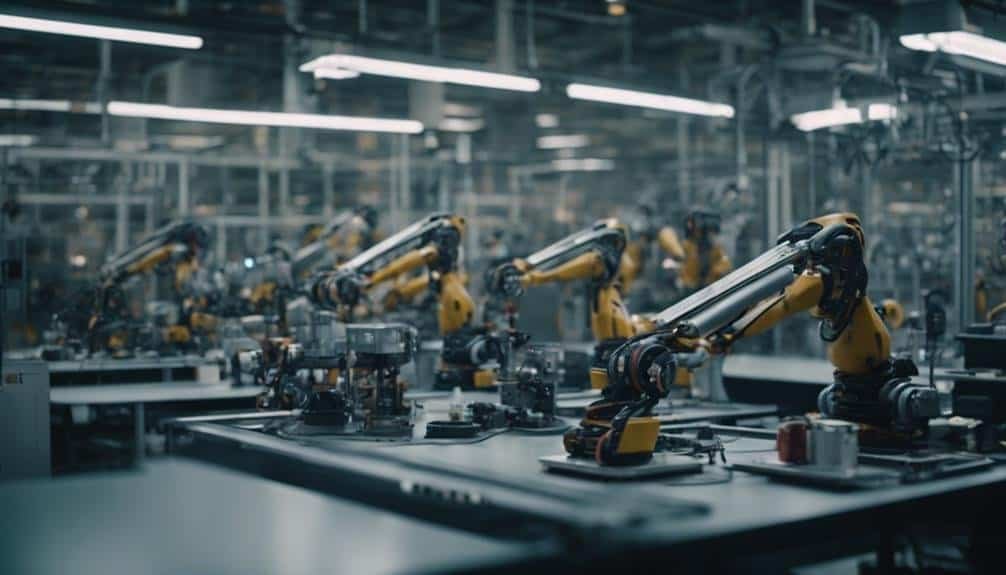AI in Predictive Maintenance: Transforming Industry Operations
In the realm of industry operations, the integration of artificial intelligence (AI) into predictive maintenance practices has been a pivotal development. AI's ability to analyze vast amounts of data and identify patterns has revolutionized how companies approach equipment upkeep.
As organizations strive for enhanced efficiency and reduced downtime, the utilization of AI in predictive maintenance holds the promise of transforming traditional maintenance routines. The impact of this technology on operational reliability and cost-effectiveness is profound, signaling a shift towards a proactive and data-driven approach to maintenance management.
Key Takeaways
- AI-driven predictive maintenance optimizes operational efficiency.
- Proactive identification reduces downtime and enhances reliability.
- Cost-effective strategies through AI integration transform maintenance processes.
- Enhanced safety and competitive edge achieved with predictive analytics.
AI's Role in Predictive Maintenance
How does artificial intelligence revolutionize the field of predictive maintenance, optimizing operational efficiency and minimizing downtime through advanced data analysis techniques?
AI algorithms play a crucial role in predictive maintenance by enabling proactive identification of potential equipment failures before they occur. By analyzing historical data, AI algorithms can detect patterns and anomalies that indicate a machine's likelihood of malfunction. This predictive capability allows maintenance teams to address issues before they escalate, thus optimizing maintenance schedules and minimizing downtime.
Maintenance optimization is another key area where AI-powered systems excel. By continuously monitoring equipment performance and analyzing real-time data, AI algorithms can recommend the most cost-effective maintenance strategies. These strategies may include predictive maintenance based on equipment condition, usage patterns, and environmental factors. By leveraging AI in this manner, organizations can streamline their maintenance processes, reduce operational costs, and extend the lifespan of their assets.
Benefits of AI-Powered Systems
Utilizing AI-powered systems in predictive maintenance offers a multitude of benefits that significantly enhance operational efficiency and reduce downtime through advanced data analysis techniques. These AI-driven solutions provide a competitive edge to industries by optimizing maintenance schedules and predicting potential failures before they occur.
The benefits of AI-powered systems include:
- Cost Efficiency: AI enables predictive maintenance, allowing organizations to move from reactive to proactive maintenance strategies. By accurately predicting when equipment is likely to fail, companies can schedule maintenance during planned downtimes, reducing unexpected breakdowns and costly repairs.
- Improved Reliability: AI algorithms analyze vast amounts of data from sensors and historical records to identify patterns indicative of potential failures. By detecting anomalies early on, AI-powered systems help enhance the reliability of equipment, leading to improved overall operational performance and minimized disruptions.
- Enhanced Safety: Predictive maintenance through AI not only improves equipment reliability but also enhances workplace safety. By preventing unexpected breakdowns, organizations can create a safer working environment for employees, reducing the risk of accidents and ensuring continued productivity.
Implementation Challenges and Solutions
Implementing AI-driven predictive maintenance systems presents organizations with a set of complex challenges that require strategic planning and innovative solutions to overcome. One significant challenge is the integration of AI with existing infrastructure and systems, which often involves compatibility issues and data silos. Another obstacle is the high initial investment required for implementing AI solutions, which can be a barrier for many organizations. Moreover, ensuring data quality and reliability for training AI models poses a challenge due to the need for vast amounts of high-quality data.
To address these challenges, organizations can adopt several solutions. Implementing robust data collection processes and investing in data quality assurance mechanisms can help improve the reliability of data used for training AI models. Collaborating with external AI experts or vendors can provide organizations with the necessary expertise to navigate complex integration challenges. Additionally, developing a clear roadmap and strategy for AI implementation can help organizations allocate resources effectively and mitigate the high initial costs associated with adopting AI-driven predictive maintenance systems.
| Challenges | Solutions |
|---|---|
| Integration with existing systems | Collaborate with AI experts or vendors |
| High initial investment | Develop a clear implementation roadmap |
| Data quality and reliability | Invest in data quality assurance mechanisms |
Case Studies of AI Success in Industry
The application of AI in various industries has demonstrated significant success through compelling case studies showcasing the effectiveness of predictive maintenance systems. Machine learning applications have played a crucial role in revolutionizing traditional maintenance practices, leading to substantial improvements in operational efficiency and cost savings.
- Increased Equipment Uptime: By implementing predictive analytics models, a manufacturing plant was able to predict machinery failures before they occurred, resulting in a 20% increase in overall equipment uptime.
- Cost Reduction: A transportation company utilized AI-driven predictive maintenance to optimize its fleet management, leading to a 15% reduction in maintenance costs and a 25% decrease in unplanned downtime.
- Enhanced Safety Measures: Through the integration of AI technologies, a utility company enhanced its safety protocols by proactively identifying potential issues in critical infrastructure, thereby reducing workplace accidents by 30%.
These case studies exemplify the tangible industry impact of predictive maintenance systems powered by AI, showcasing their ability to drive operational excellence and improve overall business outcomes.
Future Trends in Predictive Maintenance
As advancements in artificial intelligence continue to reshape the landscape of predictive maintenance, future trends are poised to further enhance the predictive capabilities of maintenance systems across various industries. One key future trend in predictive maintenance is the increased adoption of predictive analytics. By harnessing the power of advanced algorithms and data analysis techniques, predictive analytics can help organizations anticipate equipment failures and performance issues before they occur, enabling proactive maintenance strategies.
Another critical trend on the horizon is the integration of machine learning into predictive maintenance systems. Machine learning algorithms can analyze vast amounts of data to identify patterns and anomalies that may indicate potential maintenance needs. By integrating machine learning into existing predictive maintenance frameworks, organizations can improve the accuracy and efficiency of their maintenance processes.
Conclusion
In conclusion, the integration of AI in predictive maintenance has revolutionized industry operations by enhancing efficiency and reducing downtime. As the saying goes, 'A stitch in time saves nine,' highlighting the importance of proactive maintenance strategies enabled by AI technology.
Despite challenges, the benefits of AI-powered systems and successful case studies demonstrate the significant impact of predictive maintenance in optimizing asset performance and driving business success.
The future trends in predictive maintenance indicate continued advancements in AI applications for even greater operational excellence.







